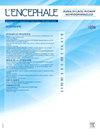在法国探索产前依恋清单的心理测量质量。
IF 1
4区 医学
Q4 NEUROSCIENCES
Encephale-Revue De Psychiatrie Clinique Biologique et Therapeutique
Pub Date : 2024-12-01
DOI:10.1016/j.encep.2023.11.014
引用次数: 0
摘要
研究目的研究目的是在法国孕妇样本中探索产前依恋量表(PAI)的结构:方法:在妇产科和社交网络上招募了 39 名孕妇。参加调查的妇女必须是孕妇,年龄在 18 至 45 岁之间,没有妊娠并发症。这些妇女填写了一份问卷,其中包括社会人口学信息和 PAI 问题。通过探索性结构方程模型(ESEM)探讨了 PAI 的结构:探讨了三种因子解决方案:双因子、三因子和四因子。由于 2 因子方案的 CFI、TLI 和 RMSEA 指数低于参考值,因此被排除在外。根据各因子所包含项目的临床意义,在三因子和四因子解决方案之间做出了选择。3 因子方案保留了以下因子:"婴儿当前和未来的表征"、"母胎关系 "和 "本体感觉"。该量表具有良好的内部一致性:PAI 是首个标准化的法语母胎依恋多维评估工具。鉴于所取得的结果,围产期护理专业人员可以推广和使用该工具。本文章由计算机程序翻译,如有差异,请以英文原文为准。
Exploring the psychometric qualities of prenatal attachment inventory in France
Objectives
The aim of the study was to explore the structure of the Prenatal Attachment Inventory (PAI) on a French sample of pregnant women.
Methods
Three hundred and nine pregnant women were recruited in gynecology-obstetrics departments and on social networks. To be included, women had to be pregnant, aged between 18 and 45 years old, and not have somatic complications of pregnancy. The women completed a questionnaire including questions on sociodemographic information, and the PAI. The structure of PAI was explored with an exploratory structural equation model (ESEM).
Results
Three factorial solutions were explored: two-, three- and four-factor. The 2-factor solution was excluded due to its CFI, TLI and RMSEA indexes, which were lower than the reference values. The choice between the 3- and 4-factor solutions was made according to the clinical meaning of the items included in the factors. The 3-factor solution was retained with the factors: “current and future representations of the baby”, “maternal–fetal relationship”, and “proprioceptive feeling”. The scale had good internal consistency.
Conclusions
The PAI is the first standardized multidimensional assessment tool for maternal–fetal attachment in the French language. In view of the results obtained, this tool can be disseminated and used by professionals in perinatal care.
求助全文
通过发布文献求助,成功后即可免费获取论文全文。
去求助
来源期刊
CiteScore
4.60
自引率
7.40%
发文量
162
审稿时长
6-12 weeks
期刊介绍:
Une revue française de renommée internationale.
- Un comite de rédaction représentant tous les aspects de la prise en charge psychiatrique du patient.
- Une sélection rigoureuse d''articles faisant l''objet de plusieurs expertises.
- Des travaux d''auteurs et de chercheurs de renommée internationale.
- Des indexations dans les grandes bases de données (Current Contents, Excerpta Medica, etc.).
- Un facteur d''impact qui témoigne de la grande notoriété de la revue.
La tribune des publications originales de haut niveau.
- Une très grande diversité des sujets traités, rigoureusement sélectionnés à travers des sommaires dynamiques :
- des éditoriaux de médecins référents,
- une revue de presse sur les actualités internationales,
- des articles originaux pour approfondir vos connaissances,
- des mises au point et des cas cliniques pour engager votre réflexion sur les indications et choix possibles au travers de mises en situation clinique,
- des dossiers thématiques pour faire le tour d''une question.
- L''actualité de l''AFPB : L''Encéphale publie régulièrement des comptes rendus de l''Association française de psychiatrie clinique.

 求助内容:
求助内容: 应助结果提醒方式:
应助结果提醒方式:


